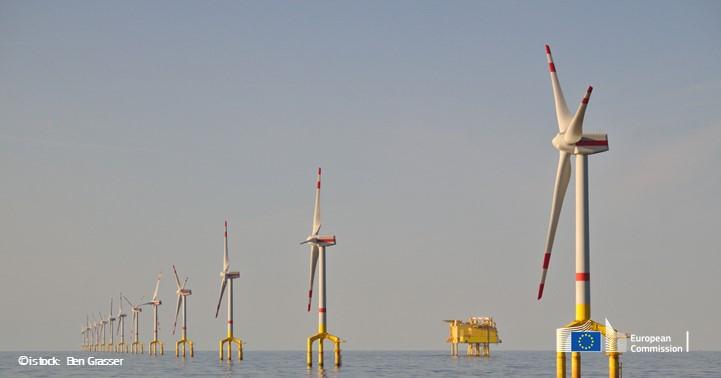
EU countries have agreed on new, ambitious long-term goals for the deployment of offshore renewable energy up to 2050 in each of the EU’s five sea basins, with intermediate objectives to be achieved by 2030 and 2040. The combined figures give an overall ambition of installing approximately 111 GW of offshore renewable generation capacity by the end of this decade - nearly twice as much as the objective of at least 60 GW set out in the EU Offshore Renewable Energy Strategy in November 2020. This then rises to around 317 GW by mid-century, reaching the very goal of the Strategy.
Agreements build on strong regional cooperation instruments and tools established by the revised Regulation on trans-European energy networks (TEN-E Regulation). By going beyond national approaches, EU countries are laying the framework for a trans-European method which allows for a cost-effective expansion of grids needed to incorporate the expected offshore renewable generation with least environmental impacts and tackle internal bottlenecks. With these milestones agreed, the European Network of Transmission System Operators for electricity (ENTSO-E) will now combine it with information on maritime spatial planning, and propose strategic integrated offshore network development plans, giving visibility to grid promoters, investors and the supply chain on what offshore grids to expect for each sea basin by 2050.
These non-binding agreements represent the first deliverable of the regulatory set-up enshrined in the revised TEN-E Regulation and build on last year’s Summits and ministerial meetings of the North Sea and Baltic Sea, which agreed the Esbjerg Declaration and the Marienborg Declaration respectively as well as the NSEC Joint Statement, taking into account the split between different sea basins.
Background
The revised TEN-E Regulation introduces key provisions to upscale offshore renewable energy in Europe by means of coordinated long-term integrated offshore and onshore grid planning. In this first key step, EU countries, with the support of the Commission, are jointly defining and agreeing on the amount of offshore renewable generation to be deployed within each sea basin by 2050, with intermediate steps in 2030 and 2040. These objectives are based on the national energy and climate plans, the offshore renewable potential of each sea basin, environmental protection, climate adaptation and other uses of the sea, as well as the EU’s decarbonisation targets.
In administrative terms, today’s agreements define the regions into the following five different sea basins:
- Northern Seas offshore grids (NSOG)
- Baltic Energy Market Interconnection Plan offshore grids (BEMIP offshore)
- South and West offshore grids (SW offshore)
- Atlantic offshore grids
- South and East offshore grids (SE offshore)
The respective non-binding agreements per sea basin will be available shortly. In some cases, the national goals are expressed as ranges, partially reflecting on-going national discussions and/or a degree of uncertainty associated with the level of future development of offshore renewable energy, especially within the 2040/2050 timeframes. As a result, the cumulative EU offshore goals have the following ranges: 109-112 GW by 2030, 215-248 GW by 2040, and 281-354 GW by 2050.
Following input and consultations with relevant transmission system operators, national regulatory authorities, EU countries and the Commission in the coming year, ENTSO-E is now tasked with developing and publishing strategic integrated offshore network development plans, as part of the wider Ten Year Network Development Plan (TYNDP), starting from the non-binding agreements reached by EU countries.
The TEN-E rules also include guidance on cross-border cost-sharing for the deployment of the sea-basin offshore network development plans, as well as support in the implementation of projects by the creation of unique points of contacts for offshore grid projects. The new provisions aim at facilitating hybrid offshore projects, a new type of project combining offshore generation and transmission capacity of several EU countries.
The agreements are non-binding and subject to revision by EU countries in line with the provisions of the revised TEN-E Regulation, as well during national exercises such as the offshore maritime spatial planning. TEN-E Regulation requires that these offshore goals are updated regularly. The first update is required by December 2024 and every two years thereafter.
Related links
Details
- Publication date
- 19 January 2023
- Author
- Directorate-General for Energy
